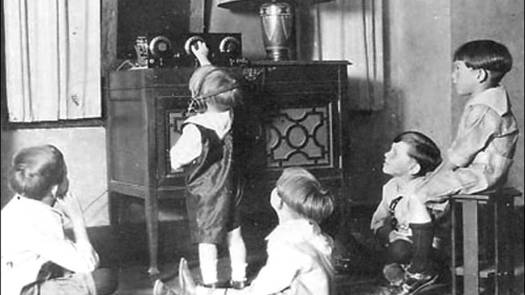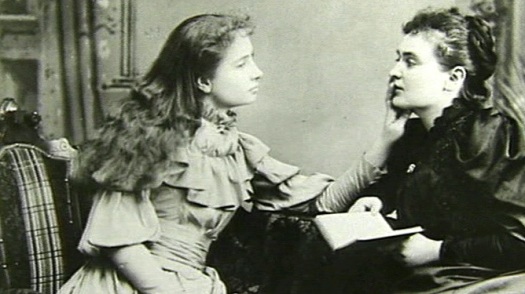Phantom Dancer :: 12:00pm 3rd Apr 2018

There’re some rare, rare early jazz radio broadcasts for your listening pleasure on this week’s Phantom Dancer. And below, read an insight from Helen Keller about how radio brought music to the deaf in the 1920s.
The Phantom Dancer is produced and presented by Australia’s only authentic 1920s-30s-style singer and band leader, Greg Poppleton.
The Phantom Dancer is your non-stop mix of swing and jazz from live 1920s-60s radio and TV. It’s made in the studios of 2SER in Sydney. The Phantom Dancer is heard across Australia on stations of the Community Radio Network.
Hear this week’s Phantom Dancer (and past Phantom Dancers online) at radio 2ser.com
In this week’s mix, you’ll hear sets of radio broadcasts by Buddy Rich, Benny Goodman over three days in October 1937 and The Andrew Sisters. There’s also a set of WW2 European dance bands from Prague, Moscow and Hilversum. The Prague recording features Andrew Sisters soundalikes, The Allan Sisters (Allanovy Sestry).
But the rare, rare radio comes from January 1929. Four ‘Sunny Meadows Washing Machine Programs’ featuring the Ray Miller Orchestra. These were recorded on five minute 78 rpm discs – six discs to a 30 minute show.
And that got me thinking about 1920s radio and how it was perceived. That’s when I found two letters from 1924 and 1926 quoted by Timmy D. Taylor in his paper, ‘Music and the Rise of Radio in 1920s
America: technological imperialism, socialization, and the transformation of intimacy’, Historical Journal of Film, Radio and Television, Vol. 22, No. 4, 2002.
The two letters come from the very early years of radio as a mass entertainment medium. They both describe how deaf people could ‘hear’ music on the radio.
HELEN KELLER REPORTS…
The first letter is from the famous deaf and blind social activist, Helen Keller, in 1924.
It is a letter to the Symphony Society of New York and describes her joy at hearing a symphonic concert on WEAF Radio, New York City.
“I have the joy of being able to tell you that, though deaf and blind, I spent a glorious hour last night listening over the radio to Beethoven’s ‘Ninth Symphony.’
I do not mean to say that I ‘heard’ the music in the sense that other people heard it; and I do not know whether I can make you understand how it was possible for me to derive pleasure from the symphony. It was a great
surprise to myself. I had been reading in my magazine for the blind of the happiness that the radio was bringing to the sightless everywhere. I was delighted to know that the blind had gained a new source of enjoyment; but
I did not dream that I could have any part in the joy.
Last night, when the family was listening to your wonderful rendering of the immortal symphony some one suggested that I put my hand on the receiver and see if I could get any of the vibrations. He unscrewed the top, and I lightly touched the sensitive diaphragm. What was my amazement to discover that I could feel, not only the vibrations, but also the impassioned rhythm, the throb and the urge of the music. The intertwined and intermingling vibrations from different instruments enchanted me. I could actually distinguish the cornets, the roll of the drums, deep-toned violas and violins singing in exquisite unison. How the lovely speech of the violins flowed and flowed over the deepest tones of the other instruments! When the human voices leaped up thrilling from the surge of harmony, I recognized them instantly as voices. I felt the chorus grow more exultant, more ecstatic, upcurving swift and flame-like, until my heart almost stood still. The women’s voices seemed an embodiment of all the angelic voices rushing in a harmonious flood of beautiful and inspiring sound. The great chorus throbbed against my fingers with poignant pause and flow. Then all the instruments and voices together burst forth—an ocean of heavenly vibration—and died away like winds with the atom is spent, ending in a delicate shower of sweet notes.
Of course, this was not hearing, but I do know that the tones and harmonies conveyed to me moods of great beauty and majesty. I also sensed, or thought I did, the tender sounds of nature that sing into my hand—swaying reeds and
winds and the murmur of streams. I have never been so enraptured before by a multitude of tone-vibrations. As I listened, with darkness and melody, shadow and sound filling all the room, I could not help remembering that the great composer who poured forth such a flood of sweetness into the world was deaf like myself. I marveled
at the power of his quenchless spirit by which out of his pain he wrought such joy for others—and there I sat, feeling with my hand the magnificent symphony which broke like a sea upon the silent shores of his soul and mine.
Let me thank you warmly for all the delight which your beautiful music has brought to my household and to me. I want also to thank Station WEAF for the joy they are broadcasting in the world.”
JAZZING THE DEAF
The second report about the deaf ‘hearing’ radio in the 1920s comes from ‘Jazzing the deaf by radio’, Popular Radio, March 1926, p. 296.
“This information has been conveyed to Paul Ash, orchestra leader and radio star of KYW in letters from several women who explain that these are the only sounds they have been able to hear and that they enjoy the jazz music although otherwise deaf.
A famous ear specialist of Chicago has become interested in the subject, it is reported, and is conducting a series of tests to determine the possibilities of utilizing this means of ‘bone conduction’ of sound so that those
who have lost normal hearing may through radio have the pleasures of music.
When the unique investigation has been completed the renowned specialist promises the issuance of a report and a test program over the air is to be given with deaf persons asked to ‘listen in’ and to report what they ‘hear’.”
VIDEOS OF THE WEEK
Your Phantom Dancer Videos of the Week feature Helen Keller herself.
In the first video, the teacher who taught her to speak, Anne Sullivan (who was blind herself), explains with Helen demonstrating, how Helen learnt to talk after hitherto being dumb as well as deaf and blind. Her first word was ‘it’. Her first sentence, “I am not dumb now.” Be amazed…
And here is a 1919 dramatisation of her childhood. The film is called ‘Deliverance’…
|
|||||||||||||||||||||||||||||||||||||||||||||||||||||||||||||||||||||||||||||||||||||||||||||||||||||||||||||||












